The Record Store Years (Side Trip): Led Zeppelin and The Fairport Connection Pt. 1: Brumbeat and The Battle Of Evermore
A memoir of 25 years (1975-2000) spent working in the world of records & music in Seattle, with occasional side trips into writings on Led Zeppelin and other adventures from my musical life.
This piece was originally published in issue #23 of my Zep fanzine Proximity in October of 1996. The original article was much longer and went into detail about Fairport Convention’s formation and history, a topic better covered by Patrick Humphries in his 1982 biography Meet On The Ledge, and more recently by Andrew Hickey on his terrific podcast A History of Rock Music in 500 Songs - https://500songs.com/podcast/song-178-who-knows-where-the-time-goes-by-fairport-convention-part-one-going-electric/
The Fairport Connection
At first glance the founders of British folk-rock and the mega-band most often accused of spawning heavy metal couldn’t seem further apart from each other in style, temperament and behavior. However, the fact remains that both Fairport Convention and Led Zeppelin formed and flourished in the same era, shared many musical influences, and in fact crossed paths as friends and compatriots on more than one occasion.
The best-known connection would be Fairport singer Sandy Denny’s vocal duet with Robert Plant on “Battle of Evermore” in 1971, although she was no longer in Fairport at the time of that recording. But the roots of the two bands go further back than that. Plant, John Bonham and Fairport bassist Dave Pegg all came up in the thriving mid-60s “Brumbeat” music scene in industrial Birmingham, England, which spawned The Move, Idle Race, The Moody Blues and Steve Winwood, and a bit later Black Sabbath, ELO, Slade, Judas Priest and others. Robert Plant and John Bonham were aspiring young players in this scene, and it was in these formative years that Pegg, Plant and Bonham first played and worked together.
Birmingham native Dave Pegg started on guitar and moved to bass when he joined The Uglys, a locally popular band fronted by Steve Gibbons. Coincidentally, a 1970s incarnation of the Steve Gibbons band included future Robert Plant guitarist Robbie Blunt, though Blunt was not from Birmingham. From The Uglys Pegg moved on to a blues trio called The Exception, known to Zeppelin collectors for their obscure single “The Eagle Flies On Friday,” which features Robert Plant on tambourine.
Above left to right: Dave Pegg in his mid-60s Brumbeat days, a club ad for the two bands that brought Pegg & Bonham together, and a teenage Bonzo working on improving his volume.
Next for Pegg was a short-lived stint in The Way Of Life, a band headed by two brothers named Chris and Reg Jones which featured an 18-year old John Bonham in the drum seat. Playing mainly R&B with a smattering of Byrds and Cream covers, the band only did about 40 gigs before they exhausted the Birmingham club scene – return engagements being somewhat rare due to Bonham’s incredibly loud playing for the time.
Pegg recalls a venue in Hertfordshire known as the Top Spot Ballroom that had a traffic light on the stage:
“It would start off at green, and when it went to amber you had ten seconds to turn the volume down, because if the light went to red, the electricity was automatically cut off! If you were in a band with Bonham you knew you’d never get booked back in those places again.
“We used to travel around together. John didn’t drive at the time because he was suffering from a driving ban, so I used to drive him about in my old Renault Dauphine. We’d do pubs and clubs; very often we’d be contracted to do two one-hour spots for about 30 dollars. We’d do the first spot and it was so loud - mainly due to John, who was the loudest drummer I’ve ever worked with - that we’d have to go home. And we’d be so broke, to get to gigs we used to siphon petrol to fill the van up.”
With the fortunes of The Way Of Life going nowhere, Pegg split the band and joined the Ian Campbell Folk Group as a standup bassist. It was in his year with this band that he developed a taste for traditional folk and established the friendship with fiddler Dave Swarbrick that would lead to him to join Fairport Convention in 1970.
Above: Robert Plant and the Band Of Joy with John Bonham in front, ca. 1967.
Bonham moved on to play with his old mate Robert Plant in the Band Of Joy for a while, followed by a stint as drummer-for-hire with Tim Rose, and then to Led Zeppelin.
It was in the early days of Zeppelin that Dave Pegg, still good friends with Bonham, brought Fairport drummer Dave Mattacks around to Bonzo’s house for a visit. According to John Paul Jones, “Bonzo always liked Dave Mattacks: rock solid, absolutely unmovable, very economical, just doing exactly what was necessary but with great feel.”
And Robert Plant concurs: “Bonzo used to get on well with Mattacks, though a greater contradiction in personalities you couldn’t find. They liked each other, and Bonzo didn’t borrow from Mattack’s style, but he was appreciative of him.”
Above: Two of Fairport Convention’s three Daves: Pegg on the left from 1970, and Mattacks on the right ca. 1973.
On the day of Pegg and Mattack’s visit, Dave Pegg recalls that “John had bought his son Jason a miniature Ludwig kit. Jason was sitting behind the kit - he was only about seven at the time - and he played “Walk Awhile,” [a Thompson/Swarbrick composition from Fairport’s Full House album]. He got everything that Mattacks was doing on the record. That’s how much of a Dave Mattacks fan John was; he taught his son to play one of the tracks off the Fairport record. Obviously, the feeling was mutual.”
On a later visit, Mattacks recalls one of the sources for his admiration of Bonham’s playing. “My recollection is the small drum kit set up beside the juke box. I remember asking John, ‘How did you do that 9/8 thing on “The Crunge”? I can’t find where one is. He sat down at that miniature drum kit, and it was that sound. That bass drum sound, that snare sound, that tom sound - out of an 18-inch bass drum, 4-inch deep snare drum and 12-inch and 14-inch toms. And I remember being half amazed at what he played and half amazed at the sound he was getting – the Zeppelin sound coming out of this little drum kit.”
Above: Jason Bonham getting a lesson from his dad (left), and Bonzo getting “That Sound” out of a miniature drum kit.
Following a chance 1970 meeting and jam between the two bands at the Troubadour in Los Angeles (details coming up in part 2), the paths of Fairport and Zeppelin diverged for the majority of the 1970s, however when Fairport decided to ‘officially’ disband in 1979, aka their ‘first farewell tour’, it was Led Zeppelin who invited them to perform with them on the bill at the Knebworth Festival on August 4, for their final gig as a band. Following this, Dave Pegg accepted a lucrative position as bassist with Jethro Tull, Simon Nicol moved on to work with the Albion Band and Richard and Linda Thompson, and Dave Swarbrick, who by this time was suffering from hearing loss, returned to the folk circuit playing small clubs, festivals and sessions.
A year later the band reunited in the tiny Oxfordshire village of Cropredy, performing an emotional and successful show that included a handful of Fairport alumni. Everyone enjoyed the event so much it was decided to make it an annual affair, and the Cropredy Festival has become one of the biggest and most popular folk festivals in England, regularly featuring performances by artists such as Richard Thompson, Robin Williamson, Andy Irvine and many, many alumni of Fairport Convention’s multiple line-ups and incarnations - usually appearing during Fairport’s long closing set on the last night of the weekend-long event.
Above left to right: Knebworth 1979 poster with Fairport at the bottom of the bill, a ticket stub from the 1980 Cropredy Festival and a bootleg CD of Robert Plant’s 1992 and 1993 performances with Fairport Convention at Cropredy.
The Cropredy Festival also attracts many guest stars, and for several years Robert Plant was a regular attendee and performer, usually singing a folk standard like “Girl From The North Country” with the band.
A particularly memorable Plant guest spot occurred in 1992, when Fairport stormed through a mini-Zeppelin set with Plant at the microphone, performing “Babe I’m Gonna Leave You,” “In The Evening” and “Ramble On.” To the delight of the Zeppelin fans in attendance, and the possible puzzlement of the more folk-oriented members of the audience, Fairport delivered note-perfect and hard rocking versions of these songs, with Mattacks doing Bonzo proud in the drum seat and guitarist Martin Allcock taking Jimmy’s original riffs as a starting point for some inspired soloing. It was as if the beast within Fairport had been unleashed, and fortunately it was all captured by an excellent audience recording which as of this writing is available on YouTube.
Going back to the Sandy Denny-Zeppelin connection: In 1970, following her departure from Fairport and her work on the first and only Fotheringay album, Sandy Denny was voted Top Female Singer in Melody Maker’s prestigious Pop Poll. It was in this same poll that Led Zeppelin shocked the music world by toppling the Beatles from their spot as the Top Group, while also grabbing Top Male Singer honors for Robert Plant, Top Album for Led Zeppelin II, and placings for Jimmy Page as #2 guitarist, John Paul Jones as #2 bassist and John Bonham as #5 drummer. Fairport Convention, by the way, also placed in this poll as #10 Top Group.
On September 16, 1970, Melody Maker held a ‘Pop Poll Party’ at London’s posh Savoy Hotel. Led Zeppelin, fresh from their wild jam with Fairport at the Troubadour and almost at the end of their sixth American tour, flew to London just to attend the event. Sandy Denny was also there, and it was on this occasion that the often seen images of Sandy posing with Plant, Page and Bonham were taken in nearby Kensington Park, probably by photographer Barry Plummer.
More importantly, it was on this day that Page and Plant approached her with the idea of guesting on Led Zeppelin’s fourth album, which at the time was in the planning stages. Zeppelin, already quite taken with traditional English folk forms and exploring acoustic directions on their third album, no doubt saw Sandy as the ideal voice to bring their call-and-response tale of an epic folktale battle to life.
Not a lot is known about the actual recording of “Battle of Evermore,” but the sessions took place at Headley Grange in Hampshire in early 1971. One can speculate that since Sandy was approached and presumably agreed to sing on the session so early in its planning stages that the song may have been composed with her vocals in mind. A rough vocal mix of the song that has surfaced could suggest that Plant intended it to be a duet right from the start, and demonstrates without a doubt that Sandy’s vocal is an essential element in the track’s success. Denny’s only comment about the session, at least on record, was a remark regarding Robert Plant’s voice in a 1973 Rolling Stone piece. “We started out soft but I was hoarse by the end, trying to keep up with him.”
Above: Robert and Sandy getting chummy at the MM Pop Poll event, September 16, 1970. Photos likely by Barry Plummer.
Much later, following the demise of Led Zeppelin, Jimmy Page made the dubious decision of staging his comeback to the music world by composing and recording the music for Michael Winner’s film Death Wish II. His choice of session musicians included Dave Mattacks as drummer for the entire project. Mattacks was a first call drummer for both session and live work at this point, but Page bringing him into the studio may have also been spurred by the fact that both of them are professed Bonham fans, and Mattacks is capable of reproducing Bonzo’s feel when the occasion requires it.
Robert Plant also brought in Fairport alumni Richard Thompson on his 1993 solo album Fate Of Nations to provide a characteristically shimmering, spooky guitar solo on “Come Into My Life,” a beautiful piece of work.
Fairport’s Cropredy Festival endures to this day, with the 2025 lineup promising some serious talent with Albert Lee, Martin Barre and of course Fairport Convention’s current lineup which still includes Simon Nicol and Dave Pegg. Unexpected guests are always expected so you never know if old Planty might show up. . .
NEXT: The Fairport Connection Pt. 2: One Night in L.A.
Below: A lineup of Brummie all-stars, gathered on the occasion of Bev Bevan opening a record shop in February 1970. Left to right: Rick Price, Ozzy Osbourne, Raymond Froggatt, Jeff Lynne, Bev Bevan, unknown, Tony Iommi and John Bonham.

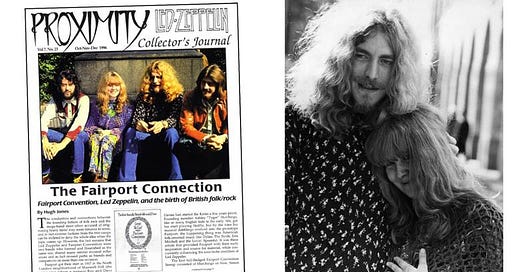




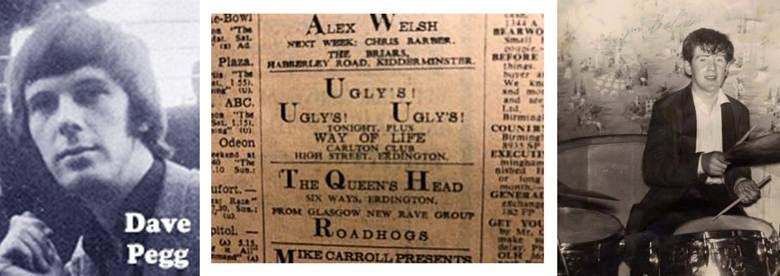
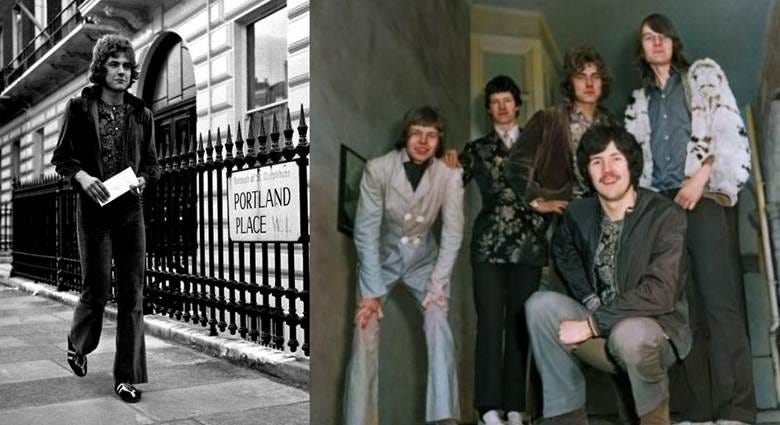
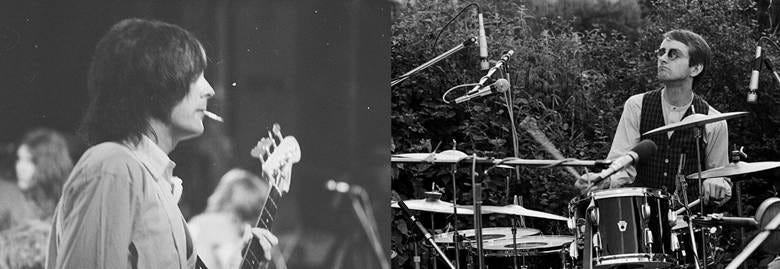
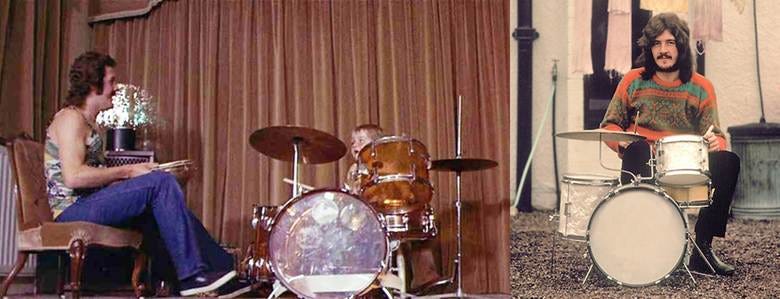

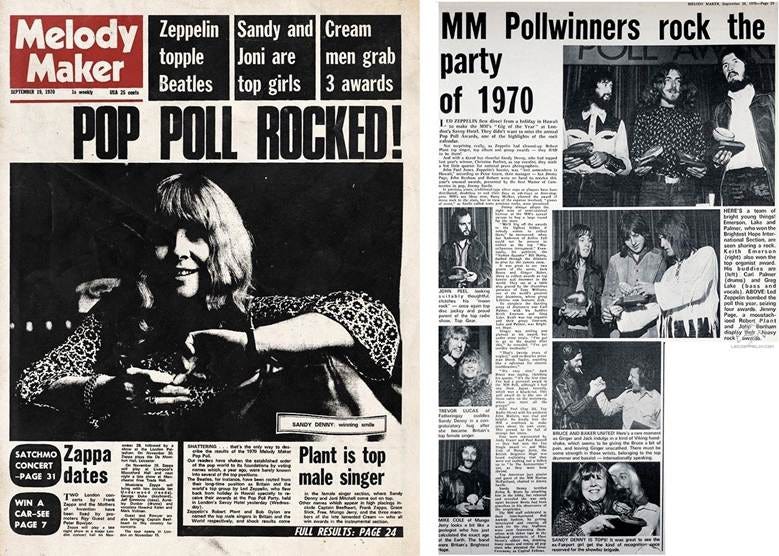
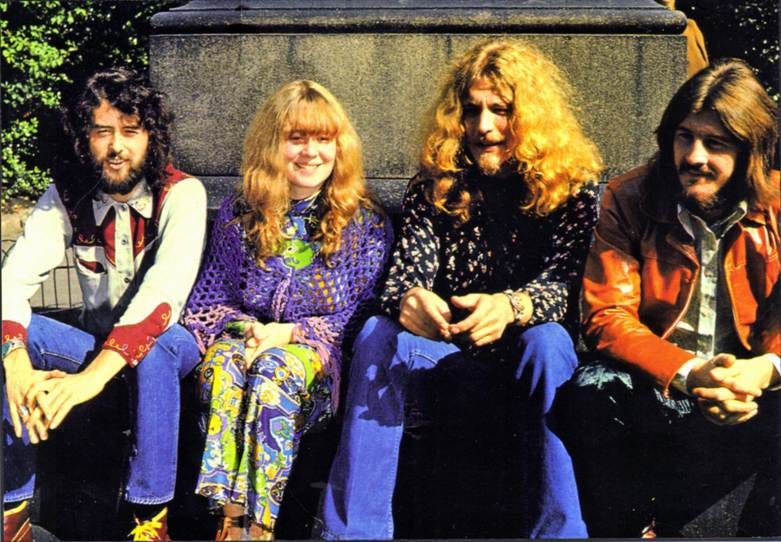

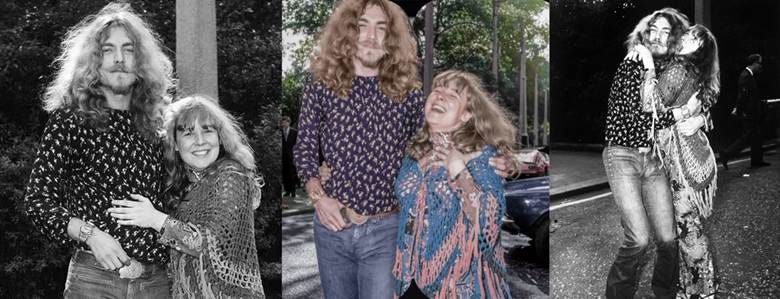
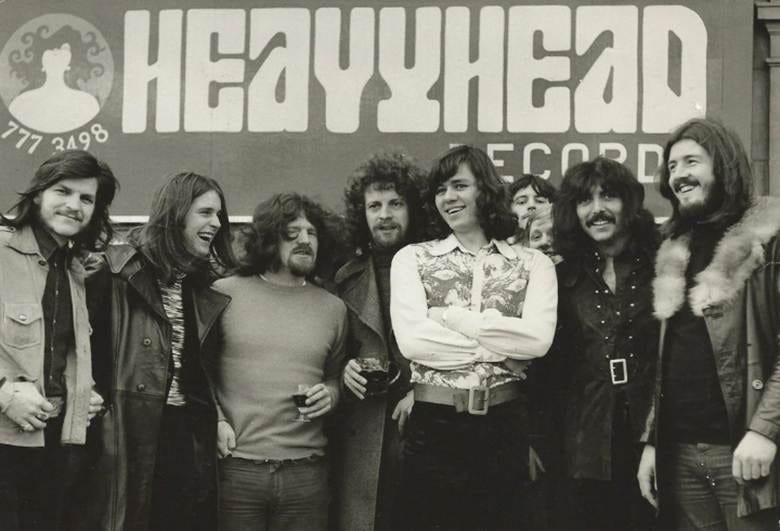
This must have taken you a lot of time to put together, Hugh. There's so much here with all the connections and the photos. The photo of Bonzo behind the miniature drum kit alone is priceless.
People tend to focus on Liverpool and Manchester as places outside London that have spawned so many groups, but as you document here Birmingham is an important epicenter in music history. I myself didn't realize just how much. I save all of your posts, but this one I have to save because it's packed with so much information.
Especially appreciated reading about Sandy Denny and her work with Led Zeppelin. I went back to listen to "Battle of Evermore" too. I did not know that she was voted Top Female Singer in Melody Maker!
I really dug this one, Hugh. As a dye-in the-wool Fairport Convention fan, I loved the Sandy Denny-Led Zeppelin collaboration on Battle For Evermore from the first time I put the needle down on Led Zep's fourth studio effort. Let's say the 10 year old version of me was pretty mesmerized by that tune. I appreciate all your research, a real deep-dive into the connections between the two bands. It was a gas to read.